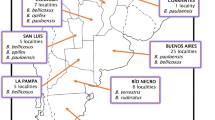Abstract
The results of bioassays using freshly killed gynes ofBelonogaster petiolata (Degeer) and hexane extracts of their tagmata and abdominal glands provide evidence for the existence of chemical signals in the venom, thorax, and head of gynes that serve as mate recognition cues and releasers of copulatory behavior in conspecific males. Attraction of males to the source of the chemicals occurs over short distances (a few centimeters).
Similar content being viewed by others
References
Akre, R.D., Reed, H.C., andLandolt, P.J. 1982. Nesting biology and behavior of the black-jacket,Vespula consobrina (Hymenoptera: Vespidae).J. Kans. Entomol. Soc. 55:373–405.
Batra, S.W.T. 1980. Sexual behavior and pheromones of the European hornet,Vespa crabro germana (Hymenoptera: Vespidae).J. Kans. Entomol. Soc. 53:461–469.
Ikan, R., Gottlieb, R., Bergmann, E.D., andIshay, J. 1969. The pheromone of the Oriental hornet,Vespa orientalis.J. Insect Physiol. 15:1709–1712.
Jeanne, R.L. 1981. Alarm recruitment, attack behavior, and the role of the alarm pheromone inPolybia occidentalis (Hymenoptera: Vespidae).Behav. Ecol. Sociobiol. 9:143–148.
Jeanne, R.L. 1982. Evidence for an alarm substance inPolistes canadensis.Experientia 38:329–330.
Kasuya, E. 1981. Male mating territory in a Japanese paper wasp,Polistes jadwigae Dalla Torre (Hymenoptera, Vespidae).Kontyû Tokyo 49:607–614.
Lin, N. 1972. Territorial behavior among males of the social waspPolistes exclamons Viereck (Hymenoptera: Vespidae).Proc. Entomol. Soc. Wash. 74:148–155.
MacDonald, J.F., Akre, R.D., andHill, W.B. 1974. Comparative biology and behavior ofVespula atropilosa andV. pensylvanica (Hymenoptera: Vespidae).Melanderia 18:1–66.
Maschwitz, U. 1964. Gefahrenalarmstoffe und Gefahrenalarmierung bei sozialen Hymenopteren.Z. Vergl. Physiol. 47:596–655.
Maschwitz, U. 1984. Alarm pheromone in the long-cheeked wasp,Dolichovespula saxonica (Hym. Vespidae).Dtsch. Entomol. Z. 31:33–34.
Post, D.C. 1980. Observations on male behavior of the eastern yellow jacket,Vespula maculifrons (Hymenoptera: Vespidae).Entomol. News 91:113–116.
Post, D.C., andJeanne, R.L. 1983a. Venom: Source of a sex pheromone in the social waspPolistes fuscatus (Hymenoptera: Vespidae).J. Chem. Ecol. 9:259–266.
Post, D.C., andJeanne, R.L. 1983b. Male reproductive behavior of the social waspPolistes fuscatus (Hymenoptera: Vespidae).Z. Tierpsychol. 62:157–171.
Post, D.C., andJeanne, R.L. 1984a. Venom as an interspecific sex pheromone, and species recognition by a cuticular pheromone in paper wasps (Polistes, Hymenoptera: Vespidae).Physiol. Entomol. 9:65–75.
Post, D.C., andJeanne, R.L. 1984b. Recognition of conspecifics and sex by territorial males of the social waspPolistes fuscatus (Hymenoptera: Vespidae).Behaviour 91:78–92.
Post, D.C., Downing, H.A., andJeanne, R.L. 1984a. Alarm response to venom by social waspsPolistes exclamans andP. fuscatus (Hymenoptera: Vespidae).J. Chem. Ecol. 10:1425–1433.
Post, D.C., Mohamed, M.A., Coppel, H.C., andJeanne, R.L. 1984b. Identification of ant repellent allomone produced by social waspPolistes fuscatus (Hymenoptera: Vespidae).J. Chem. Ecol. 10:1799–1807.
Ross, K.G. 1983. Laboratory studies of the mating biology of the eastern yellowjacket,Vespula maculifrons (Hymenoptera: Vespidae).J. Kans. Entomol. Soc. 56:523–537.
Sandeman, R.D. 1938. The swarming of the males ofVespula sylvestris (Scop.) around a queen.Proc. R. Entomol. Soc. London Ser. A 13:87–88.
Thomas, C.R. 1960. The European wasp (Vespula germanica) in New Zealand.N.Z. Dept. Sci. Ind. Res. Inf. Ser. 17:1–74.
Turillazzi, S., andCervo, R. 1982. Territorial behavior in males ofPolistes nimpha (Christ) (Hymenoptera, Vespidae).Z. Tierpsychol. 58:174–180.
Veith, H.J., andKoeniger, N. 1978. Identifiziering voncis-9-Pentacosen als Ausloser fur das Warmen der Brut bei der Hornisse.Naturwissenschaften 65:263.
Veith, H.J., Koeniger, N., andMaschwitz, U. 1984. 2-Methyl-3-butene-2-ol, a major component of the alarm pheromone of the hornetVespa crabro.Naturwissenschaften 71:328–329.
Wheeler, J.W., Ayorinde, F.O., Greene, A., andDuffield, R.M. 1982. Citronellyl citronellate and citronellyl geranate in the European hornet,Vespa crabro (Hymenoptera: Vespidae).Tetrahedron Lett. 23:2071–2072.
Author information
Authors and Affiliations
Rights and permissions
About this article
Cite this article
Keeping, M.G., Lipschitz, D. & Crewe, R.M. Chemical mate recognition and release of male sexual behavior in polybiine wasp,Belonogaster petiolata (Degeer) (Hymenoptera: Vespidae). J Chem Ecol 12, 773–779 (1986). https://doi.org/10.1007/BF01012109
Received:
Accepted:
Issue Date:
DOI: https://doi.org/10.1007/BF01012109




